#conjecture
Explore tagged Tumblr posts
Text
Nick Blaine doesn’t smell like Lavendar or Linen.
He smells like smoke and sweat. Musk and coffee and burbon. Aftershave. Maybe a touch of cologne.
25 notes
·
View notes
Note
A part of me kind of thinks that they didn't have to show Audrey being outright verbally abusive towards Chloe? Neglect is Also Bad, and I think it would've made a lot of sense if Audrey was just. Not present and completely apathetic- which still doesn't make her a good parent! And Andre is there catering to their every whim, and Chloe is raised to think of this as acceptable behavior. She's a child, copying her mother, because nobody has ever intervened or told her that kind of thing is Not Okay, and she seeks her mother's approval by trying to emulate Audrey.
Also then it wouldn't have directly undermined Felix's whole "no child deserves an abusive parent" point from Pretension- which gets contradicted in Revolution when Chloe "gets what she deserves" by being sent to live with Audrey. Who immediately starts screaming at her in exactly the same manner Colt does with Felix in the play, which IS explicitly framed as abuse. Ignoring the main plot they did with Felix- his points there were incredibly valid and then swept under the rug less than 2 seconds later and never mentioned again.
I believe the problem is that TA thinks it is funny when it happens to Chloé. She's a 'bad person' and just judging from his overall statements. I think jis philosophy would be that it is fine to show a bad person being mistreated and laugh. After all, they are bad. If they wanted sympathy they should have been good.
This is of course, a heinous way of thinking. The intrinsic nature/earned personhood thinking mindset marches to the same endpoint at Fascist ideology, just in different boots.
27 notes
·
View notes
Text
Call me the leader of the arcane council the way I'm a high wizard
#wizard garms#wizardposting#wizard tailors#wizard high#wizard council#shadow wizard money gang#conjecture#wizard#wizard shit#wizardblogging
102 notes
·
View notes
Text
Well, since Wheel of Time isn't getting renewed, I feel fine sharing my headcanon/conjecture of how they were going to resolve Siuan's death with the books.
Somehow, someway, Elaida would die by balefire.
#wheel of time spoilers#conjecture#pure speculation#but introducing balefire the same episode they kill off a major character?#extremely sus#i can also headcanon that loial is still alive#no body no death#thats my motto
11 notes
·
View notes
Text
This weekend, both for my own edification and on the off-chance it might help someone else keep things straight, I replayed or revisited a bunch of missions and quests to recap the timeline between New War, Duviri Paradox, and the upcoming 1999. (You can watch it here, even, plug plug.)
A few more (somewhat spoilery) thoughts from this replay session:
Hope you listened to all of the Albrecht Requiem recordings in Deimos's hidden chamber, because those revelations underpin a great deal of the story arc from here on out.
Boy howdy, they are really going all-in on the "love wins" theme in a number of ways (Whispers in the Walls, Jade Shadows, etc.). Which is great, I love a subversively positive literary theme when the work is put in. And if that's any indication of the tone of the writing going forward, 1999 and the Hex storylines are going to be a hurt/comfort bonanza.
"You are late" happens at the stroke of midnight. Something about the moment of January 1st, 2000 lets the Man in the Wall in. I have a feeling that keeping the Indifference at bay involves keeping Hollovania and the Hex in a permanent state of 1999... eternally.
Loid really needs his problematic boyfriend back, dammit. (On a repeat playthrough, WitW does a really good job of selling us on how perfect these two too-smart-for-their-own-good drama-queens are for each other.)
As a corollary to 3, I have a sneaking suspicion that the overarching mission of "find and secure Dr. Entrati" is not going to be exactly... complete at the end of 1999's main story quest. The post-quest status quo might have the Hex in a perpetual state of "looking for Dr. Entrati" eternally. The actual stuff that advances the status quo will have to come later. But this is the one I'm least sure of, so we'll see!
You bet I'm gonna be streaming 1999 on day one. I'm way too invested, as ever.
#warframe#warframe 1999#warframe spoilers#conjecture#analysis#whispers in the walls#jade shadows#lotus eaters#thoughts
13 notes
·
View notes
Text
Here is a fun theorem: Consider 31 points evenly spaced on a circle, and color each of them arbitrarily blue or red. Then we can always find 5 points with the same color that divide the circle into arcs proportional to 1 : 2 : 4 : 8 : 16. The arcs need not be in the order suggested by the proportion. That is, 1 : 4 : 8 : 2 : 16 counts as a success!
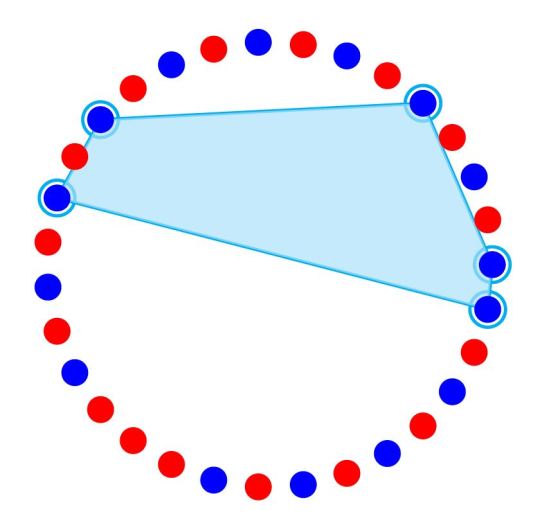
One of my favorite open problem is whether the generalization of this holds:
Stromquist's conjecture: For any k>= 3, consider (2^k)-1 points evenly spaced on a circle, and color each of them arbitrarily blue or red. Then we can always find k points with the same color that divide the circle into arcs proportional to 1:2:4: ... :2^(k-1), but not necessarily in this order.
I managed to prove this up to k=7 using a computer. Can you push it further?
82 notes
·
View notes
Text
idk, if lestat and louis get to reunite kinda feel like they have some wild catching up to do. like how do you broach the un-negotiated 80-year Maitre/Arun 24/7 lifestyle that became your life
how do you re-meet someone who lived an entire lifetime without you, rolin don't leave me hanging, anne rice totally left me hanging on this one
#loustat#questions questions#i'm jumping ahead but the implications have me by the throat#conjecture#iwtv#iwtv spoilers#iwtv book spoilers
14 notes
·
View notes
Text

Todays Word Of The Day is: Conjecture
Conjecture originates from the Latin conjectura(guess). English usage of the word began in the 14th century.
#word unscrambler#word of the day#interpretation#notion#idea#postulation#guess#presumption#supposition#opinion#inference#surmise#theory#assumption#conjecture#speculation#hypothesis
2 notes
·
View notes
Text
Words of the Day
consort:
A husband or wife, especially the spouse of a monarch.
A companion or partner.
An animal with which another animal, usually of the opposite sex, forms a bond for a temporary period during which the two individuals maintain close proximity and engage in mating or other sexual behavior.
languid:
Lacking energy or disinclined to exert effort; listless.
Slow-moving or weak in force.
Showing little or no vitality or animation.
jargon:
The specialized language of a trade, profession, or similar group, especially when viewed as difficult to understand by outsiders.
Nonsensical or incoherent language.
A hybrid language or dialect; a pidgin. Not in technical use.
transmute:
To change from one form, nature, substance, or state into another; transform.
To undergo transmutation.
conjecture:
Opinion, or judgment based on inconclusive or incomplete evidence; guesswork.
An opinion, or conclusion, formed on defective or presumptive evidence; probable inference; surmise; guess; suspicion.
doublespeak:
Any language deliberately constructed to disguise or distort its actual meaning, often by employing euphemism or ambiguity. Typically used by governments or large institutions.
Any language that pretends to communicate but actually does not.
~~~
I find it interesting that the definition of consort went from "spouse", to "gf/bf", to "just some animal you're currently fucking".
There was a lot of conjecture in "The Apothecary Diaries". I really enjoy mystery anime. That series really drew me in. The period-piece setting was also very comforting. I was truly transported. I was languid that week -- I really didn't want to get up and do anything -- "The Apothecary Diaries" was a great temporary escape for me.
There's 'say one thing, mean another' and there's 'say one thing, mean no thing'. The latter is doublespeak. Just STFU please.
#consort#words of the day#words#definitions#dictionary#vocabulary#language#languid#jargon#transmute#conjecture#doublespeak#the apothecary diaries#anime
5 notes
·
View notes
Text
Many string theorists, including me, strongly suspect that something along these lines actually happens, but to go further we need to figure out the more fundamental concepts into which space and time transform.*
* I might note that the proponents of another approach for merging general relativity and quantum mechanics, loop quantum gravity, to be briefly discussed Chapter 16, take a viewpoint that is closer to the former conjecture – that spacetime has a discrete structure on the smallest of scales.
"The Fabric of the Cosmos" - Brian Greene
#book quotes#the fabric of the cosmos#brian greene#nonfiction#string theory#fundamental#space#time#transformation#loop quantum gravity#quantum mechanics#conjecture#spacetime
2 notes
·
View notes
Text
The God of the Corycian Cave
“Nothing yet found at Olba [in Anatolia, modern-day Republic of Türkiye] throws light on the nature of the god who was worshipped there under the Greek name of Zeus. But at two places near the coast, distant only some fourteen or fifteen miles from Olba, a deity also called Zeus by the Greeks was revered in natural surroundings of a remarkable kind, which must have stood in close relation with the worship, and are therefore fitted to illustrate it. In both places the features of the landscape are of the same general cast, and at one of them the god was definitely identified with the Zeus of Olba. The country here consists of a tableland of calcareous rock rent at intervals by those great chasms which are characteristic of a limestone formation. Similar fissures, with the accompaniment of streams or rivers which pour into them and vanish under ground, are frequent in Greece, and may be observed in our own country [i.e., England] near Ingleborough [a mountain] in Yorkshire. Fossil bones of extinct animals are often found embedded in the stalagmite or breccia [a type of sedimentary rock] of limestone caves. For example, the famous Kent's Hole near Torquay [in England] contained bones of the mammoth, rhinoceros, lion, hyaena, and bear; and red osseous breccias, charged with the bones of quadrupeds which have long disappeared from Europe, are common in almost all the countries bordering on the Mediterranean. Western Cilicia is richer in Miocene deposits than any other part of Anatolia, and the limestone gorges of the coast near Olba are crowded with fossil oysters, corals, and other shells. Here, too, within the space of five miles the limestone plateau is rent by three great chasms, which Greek religion associated with Zeus and Typhon. One of these fissures is the celebrated Corycian cave.

Corycian Cave, exterior view.
(Source: Zde, CC BY-SA 4.0 https://creativecommons.org/licenses/by-sa/4.0, via Wikimedia Commons)
“To visit this spot, invested with the double charm of natural beauty and legendary renown, you start from the dead Cilician city of Corycus on the sea, with its ruined walls, towers, and churches, its rock-hewn houses and cisterns, its shattered mole [harbor], its island-fortress, still imposing in decay. Viewed from the sea, this part of the Cilician coast, with its long succession of white ruins, relieved by the dark wooded hills behind, presents an appearance of populousness and splendour. But a nearer approach reveals the nakedness and desolation of the once prosperous land. Following the shore westward from Corycus for about an hour you come to a pretty cove enclosed by wooded heights, where a spring of pure cold water bubbles up close to the sea, giving to the spot its name of Tatlu-su, or the Sweet Water. From this bay a steep ascent of about a mile along an ancient paved road leads inland to a plateau. Here, threading your way through a labyrinth or petrified sea of jagged calcareous rocks, you suddenly find yourself on the brink of a vast chasm which yawns at your feet. This is the Corycian cave. In reality it is not a cave but an immense hollow or trough in the plateau, of oval shape and perhaps half a mile in circumference. The cliffs which enclose it vary from one hundred to over two hundred feet in depth. Its uneven bottom slopes throughout its whole length from north to south, and is covered by a thick jungle of trees and shrubs—myrtles, pomegranates, carobs, and many more, kept always fresh and green by rivulets, underground water, and the shadow of the great cliffs. A single narrow path leads down into its depths. The way is long and rough, but the deeper you descend the denser grows the vegetation, and it is under the dappled shade of whispering leaves and with the purling of brooks in your ears that you at last reach the bottom. The saffron which of old grew here among the bushes is no longer to be found, though it still flourishes in the surrounding district. This luxuriant bottom, with its rich verdure, its refreshing moisture, its grateful shade, is called Paradise by the wandering herdsmen. They tether their camels and pasture their goats in it and come hither in the late summer to gather the ripe pomegranates. At the southern and deepest end of this great cliff-encircled hollow you come to the cavern proper. The ruins of a Byzantine church, which replaced a heathen temple, partly block the entrance. Inwards the cave descends with a gentle slope into the bowels of the earth. The old path paved with polygonal masonry still runs through it, but soon disappears under sand. At about two hundred feet from its mouth the cave comes to an end, and a tremendous roar of subterranean water is heard. By crawling on all fours you may reach a small pool arched by a dripping stalactite-hung roof, but the stream which makes the deafening din is invisible. It was otherwise in antiquity. A river of clear water burst from the rock, but only to vanish again into a chasm. Such changes in the course of streams are common in countries subject to earthquakes and to the disruption caused by volcanic agency. The ancients believed that this mysterious cavern was haunted ground. In the rumble and roar of the waters they seemed to hear the clash of cymbals touched by hands divine.
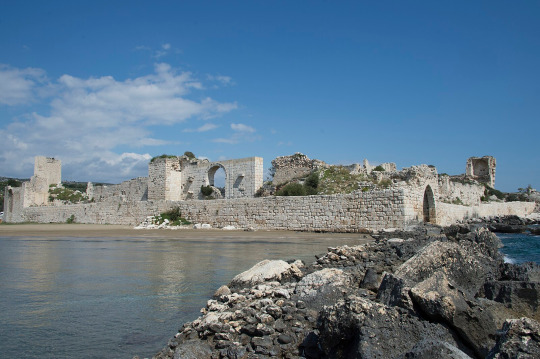
The island-fortress and mole at Korykos (Corycus).
(Source: Dosseman, CC BY-SA 4.0 https://creativecommons.org/licenses/by-sa/4.0, via Wikimedia Commons)
“If now, quitting the cavern, we return by the same path to the summit of the cliffs, we shall find on the plateau the ruins of a town and of a temple at the western edge of the great Corycian chasm. The wall of the holy precinct was built within a few feet of the precipices, and the sanctuary must have stood right over the actual cave and its subterranean waters. In later times the temple was converted into a Christian church. By pulling down a portion of the sacred edifice Mr. [James Theodore] Bent had the good fortune to discover a Greek inscription containing a long list of names, probably those of the priests who superintended the worship. One name which meets us frequently in the list is Zas, and it is tempting to regard this as merely a dialectical form of Zeus. If that were so, the priests who bore the name might be supposed to personate the god. But many strange and barbarous-looking names, evidently foreign, occur in the list, and Zas may be one of them. However, it is certain that Zeus was worshipped at the Corycian cave; for about half a mile from it, on the summit of a hill, are the ruins of a larger temple, which an inscription proves to have been dedicated to Corycian Zeus.
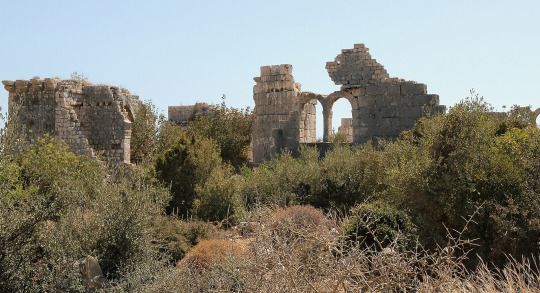
Ruins of a basilica at Korykos.
(Source: Ingeborg Simon, CC BY-SA 3.0 https://creativecommons.org/licenses/by-sa/3.0, via Wikimedia Commons)
“But Zeus, or whatever native deity masqueraded under his name, did not reign alone in the deep dell. A more dreadful being haunted a still more awful abyss which opens in the ground only a hundred yards to the east of the great Corycian chasm. It is a circular cauldron, about a quarter of a mile in circumference, resembling the Corycian chasm in its general character, but smaller, deeper, and far more terrific in appearance. Its sides overhang and stalactites droop from them. There is no way down into it. The only mode of reaching the bottom, which is covered with vegetation, would be to be lowered at the end of a long rope. The nomads call this chasm Purgatory, to distinguish it from the other which they name Paradise. They say that there is a subterranean passage between the two, and that the smoke of a fire kindled in the Corycian cave may be seen curling out of the other. The one ancient writer who expressly mentions this second and more grisly cavern is Mela, who says that it was the lair of the giant Typhon, and that no animal let down into it could live. Aeschylus puts into the mouth of Prometheus an account of ‘the earth-born Typhon, dweller in Cilician caves, dread monster, hundred-headed,’ who in his pride rose up against the gods, hissing destruction from his dreadful jaws, while from his Gorgon eyes the lightning flashed. But him a flaming levin bolt, crashing from heaven, smote to the very heart, and now he lies, shrivelled and scorched, under the weight of Etna by the narrow sea. Yet one day he will belch a fiery hail, a boiling angry flood, rivers of flame, to devastate the fat Sicilian fields. This poetical description of the monster, confirmed by a similar passage of Pindar, clearly proves that Typhon was conceived as a personification of those active volcanoes which spout fire and smoke to heaven as if they would assail the celestial gods. The Corycian caverns are not volcanic, but the ancients apparently regarded them as such, else they would hardly have made them the den of Typhon.
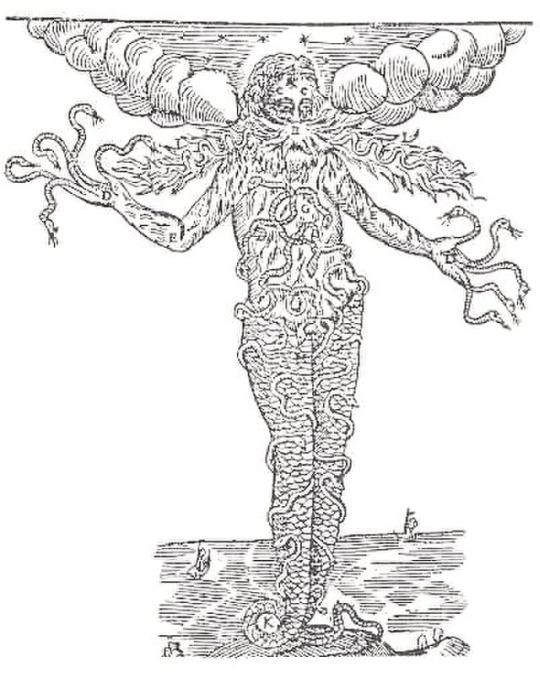
An engraving of Typhon, from the first volume of Athanasius Kircher's Oedipus Aegyptiacus (1652-54).
(Source: Athanasius Kircher, Public Domain, via Wikimedia)
“According to one legend Typhon was a monster, half man and half brute, begotten in Cilicia by Tartarus upon the goddess Earth. The upper part of him was human, but from the loins downward he was an enormous snake. In the battle of the gods and giants, which was fought out in Egypt, Typhon hugged Zeus in his snaky coils, wrested from him his crooked sword, and with the blade cut the sinews of the god's hands and feet. Then taking him on his back he conveyed the mutilated deity across the sea to Cilicia, and deposited him in the Corycian cave. Here, too, he hid the severed sinews, wrapt in a bear's skin. But Hermes and Aegipan contrived to steal the missing thews and restore them to their divine owner. Thus made whole and strong again, Zeus pelted his beaten adversary with thunderbolts, drove him from place to place, and at last overwhelmed him under Mount Etna. And the spots where the hissing bolts fell are still marked by jets of flame….
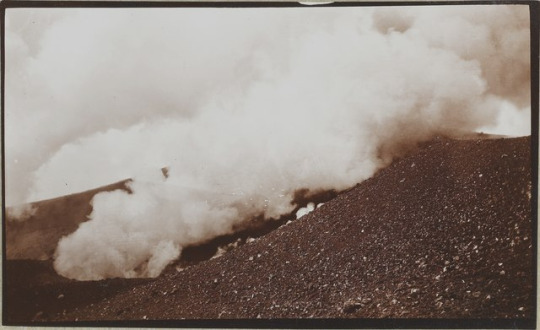
A photograph of Mount Ætna in Sicily, by Immanuel Friedlaender (1910).
(Source: Immanuel Friedlaender, Public domain, via Wikimedia Commons)
“About five miles to the north-east of the Corycian impassable rocks, is another and very similar chasm. It may be reached in about an hour and a quarter from the sea by an ancient paved road, which ascends at first very steeply and then gently through bush-clad and wooded hills. Thus you come to a stretch of level ground covered with the well-preserved ruins of an ancient town. Remains of fortresses constructed of polygonal masonry, stately churches, and many houses, together with numerous tombs and reliefs, finely chiselled in the calcareous limestone of the neighbourhood, bear witness to the extent and importance of the place. Yet it is mentioned by no ancient writer. Inscriptions prove that its name was Kanyteldeis or Kanytelideis, which still survives in the modern form of Kanidiwan [Kanlıdivane, in the Republic of Türkiye]. The great chasm opens in the very heart of the city. So crowded are the ruins that you do not perceive the abyss till you are within a few yards of it. It is almost a complete circle, about a quarter of a mile wide, three-quarters of a mile in circumference, and uniformly two hundred feet or more in depth. The cliffs go sheer down and remind the traveller of the great quarries at Syracuse [in Sicily]. But like the Corycian caves, the larger of which it closely resembles, the huge fissure is natural; and its bottom, like theirs, is overgrown with trees and vegetation. Two ways led down into it in antiquity, both cut through the rock. One of them was a tunnel, which is now obstructed; the other is still open. Remains of columns and hewn stones in the bottom of the chasm seem to show that a temple once stood there. But there is no cave at the foot of the cliffs, and no stream flows in the deep hollow or can be heard to rumble underground. A ruined tower of polygonal masonry, which stands on the southern edge of the chasm, bears a Greek inscription stating that it was dedicated to Olbian Zeus by the priest Teucer, son of Tarkuaris. The letters are beautifully cut in the style of the third century before Christ. We may infer that at the time of the dedication the town belonged to the priestly kings of Olba, and that the great chasm was sacred to Olbian Zeus.
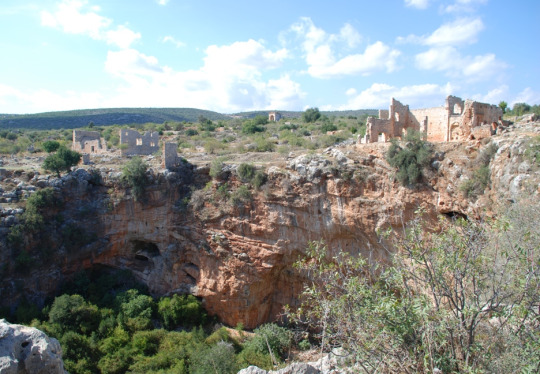
The chasm at the center of the ruins of the Greek city once known as Kanyteldeis.
(Source: Elelicht, CC BY-SA 3.0 https://creativecommons.org/licenses/by-sa/3.0, via Wikimedia Commons)
“What, then, was the character of the god who was worshipped under the name of Zeus at these two great natural chasms? The depth of the fissures, opening suddenly and as it were without warning in the midst of a plateau, was well fitted to impress and awe the spectator; and the sight of the rank evergreen vegetation at their bottom, fed by rivulets or underground water, must have presented a striking contrast to the grey, barren, rocky wilderness of the surrounding tableland. Such a spot must have seemed to simple folk a paradise, a garden of God, the abode of higher powers who caused the wilderness to blossom, if not with roses, at least with myrtles and pomegranates for man, and with grass and underwood for his flocks.… In rainless countries the sky-god is deprived of one of the principal functions which he discharges in cool cloudy climates like that of Europe. He has, in fact, little or nothing to do with the water-supply, and has therefore small excuse for levying a water-rate on his worshippers. Not, indeed, that Cilicia is rainless; but in countries bordering on the Mediterranean the drought is almost unbroken through the long months of summer. Vegetation then withers: the face of nature is scorched and brown: most of the rivers dry up and only their white stony beds, hot to the foot and dazzling to the eye, remain to tell where they flowed. It is at such seasons that a green hollow, a shady rock, a murmuring stream, are welcomed by the wanderer in the South with a joy and wonder which the untravelled Northerner can hardly imagine. Never do the broad slow rivers of England, with their winding reaches, their grassy banks, their grey willows mirrored with the soft English sky in the placid stream, appear so beautiful as when the traveller views them for the first time after leaving behind him the aridity, the heat, the blinding glare of the white southern landscape, set in seas and skies of caerulean blue.

The ruins of Kanyteldeis, now known as Kanlıdivane.
(Source: Dosseman, CC BY-SA 4.0 https://creativecommons.org/licenses/by-sa/4.0, via Wikimedia Commons)
“We may take it, then, as probable that the god of the Corycian and Olbian caverns was worshipped as a source of fertility. In antiquity, when the river, which now roars underground, still burst from the rock in the Corycian cave, the scene must have resembled Ibreez [at Cappadocia in Anatolia], where the god of the corn and the vine was adored at the source of the stream; and we may compare the vale of Adonis in the Lebanon, where the divinity who gave his name to the river was revered at its foaming cascades. The three landscapes had in common the elements of luxuriant vegetation and copious streams leaping full-born from the rock. We shall hardly err in supposing that these features shaped the conception of the deities who were supposed to haunt the favoured spots. At the Corycian cave the existence of a second chasm, of a frowning and awful aspect, might well suggest the presence of an evil being who lurked in it and sought to undo the beneficent work of the good god. Thus we should have a fable of a conflict between the two, a battle of Zeus and Typhon.

Temple of Zeus in Olba, in the Republic of Türkiye.
(Source: HALUK COMERTEL, CC BY 3.0 https://creativecommons.org/licenses/by/3.0, via Wikimedia Commons)
“On the whole we conclude that the Olbian Zeus, worshipped at one of these great limestone chasms, and clearly identical in nature with the Corycian Zeus, was also identical with the Baal of Tarsus, the god of the corn and the vine, who in his turn can hardly be separated from the god of Ibreez. If my conjecture is right the native name of the Olbian Zeus was Tark or Trok, and the priestly Teucers of Olba represented him in their own persons. On that hypothesis the Olbian priests who bore the name of Ajax embodied another native deity of unknown name, perhaps the father or the son of Tark. A comparison of the coin-types of Tarsus with the Hittite monuments of Ibreez and Boghaz-Keui led us to the conclusion that the people of Tarsus worshipped at least two distinct gods, a father and a son, the father-god being known to the Semites as Baal and to the Greeks as Zeus, while the son was called Sandan by the natives, but Hercules by the Greeks. We may surmise that at Olba the names of Teucer and Ajax designated two gods who corresponded in type to the two gods of Tarsus; and if the lesser figure at Ibreez, who appears in an attitude of adoration before the deity of the corn [i.e., of the grain] and the vine, could be interpreted as the divine Son in presence of the divine Father, we should have in all three places the same pair of deities, represented probably in the flesh by successive generations of priestly kings. But the evidence is far too slender to justify us in advancing this hypothesis as anything more than a bare conjecture.”
—J. G. Frazer, Adonis, Attis, Osiris, part 1 (The Golden Bough, vol. V, 1914, pp. 152-161)
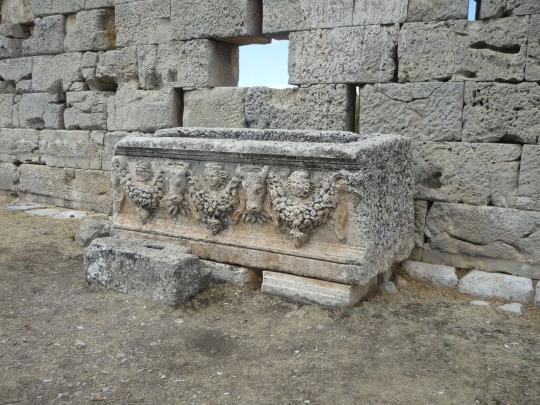
A sarcophagus in the Temple of Zeus Olbius.
(Source: Cobija, CC BY-SA 3.0 https://creativecommons.org/licenses/by-sa/3.0, via Wikimedia Commons)
#long post#beautiful writing#jg frazer#the golden bough#the golden bough vol v#adonis attis osiris#exemplary prose#conjecture#korykos#turkiye#turkey#anatolia#olba#greece#cilicia#corycian cave#Zeus#Zeus Olbius#typhon#james theodore bent#Kanlıdivane#kanyteldeis#nature writing#travel writing#cappadocia#ibreez#comparative religion#comparative mythology
1 note
·
View note
Text
Conjucture About the Rhombic Penrose Tiling
Roger Penrose is famous for many things, including the discovery of aperiodic tilings, the most familiar of which involves two types of rhombus: I think I have made a minor discovery about this Penrose tiling, and that is that one can add regular pentagons to it, in varying levels of pentagon-density, as shown in the first image, without it losing its aperiodicity. (I created only the first…

View On WordPress
2 notes
·
View notes
Text

MacRitchie, D., Goeje, M. J. de (Michael Jan)., Snijders, J. (1886). Accounts of the Gypsies of India. London: K. Paul, Trench & co.
2 notes
·
View notes
Note
Since I've failed to properly set up my messaging spells under my wizardly identity, I've had to resort to using this poor vessel I found called "anon" to ask a question on the behest of my true self, @casters-coture . It's quite amazing to see a fellow maker of fine robes and garments here on this plane since my shop did another realm jump! Shadow Wizard Tailors Gang...is this an actual coalition or union of fashion savvy wizards? Are you, or any other dashing robe makers, open to business partnerships or future collaborations on arcane attire? My sincerest apologies if I come off too strong, being a stranger in these new whimsical lands. ~ Mx. Scorpio D'Magos, Mage of the Stage
Ah! Greetings! Good to see a fellow purveyor of wizarding garments!
Unfortunately, currently, unless you know of any others, shadow wizard tailors gang is just me but I thought it sounded cool! I would absolutely be open to future partnerships! I'm always looking for new inspiration and fellow collaborators with whom I can share my love for fine robes and hats!!
Welcome to the area! It's good to have you around!
All the best,
~ Poly Manteaux - sorcerer of silks
#wizard garms#wizardposting#asks!#asks#wizard tailors#conjecture#wizard fashion#wizard#wizard shit#shadow wizard tailors gang
13 notes
·
View notes
Note
So from what I’ve observed, a good amount of the fandom believes that A & O is a casual situation (Even though she’s not the most reliable, DeuxMoi has said the same thing). I’m a bit new to the AG fandom so I’m not too familiar with his dating history, but I’ve seen discourse about it, and apparently he’s no stranger to casual flings. Do you think this Olivia situation could be just another short fling/a part of a hoe phase?
Look dear, I’ve been following Andrew for a long time. With greater intensity from the last months of 2021, with mostly here on Tumblr. He hasn’t had a long-term relationship since Emma. And yes, he’s really no stranger to casual flings. And based on my observations about those short-term relationships he’s been in, I believe that A&O is just something casual, and nothing more. I like him, but I’m not gonna dress him up as a perfect prince. He’s human, first of all. And he’s probably still in his fuckboi era.
#ask box#my thoughts#about that#andrew garfield#in his fuckboi era#ex girlfriend#emma stone#alyssa miller#olivia brower#girlfriend?#maybe#maybe not#who knows#i'm no longer feeling firm in this#short flings#conjecture#ask anon#ask response
2 notes
·
View notes
Text
yknow i’ve been talking more undertale stuff recently and i gotta say. i think the neutral route is my favorite solely on the variation of outcomes in the ending (and how generally weird it is overall) ((also honestly i think it does a better job than the genocide run when it comes to player guilt and questioning/condemning your actions))
#undertale#genocide route#neutral route#conjecture#i will probably go into more detail about this later
2 notes
·
View notes